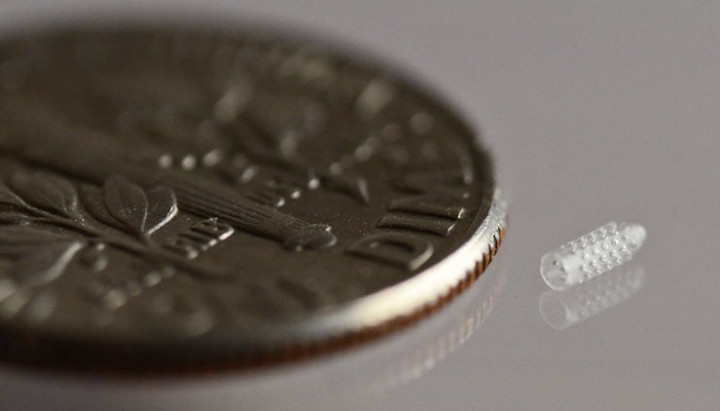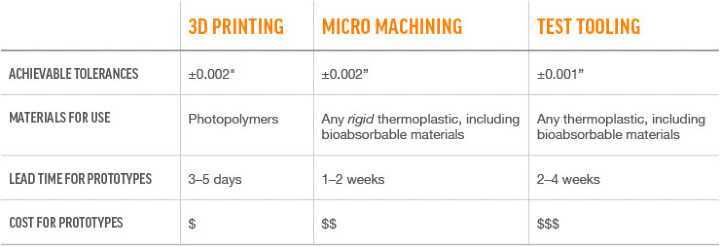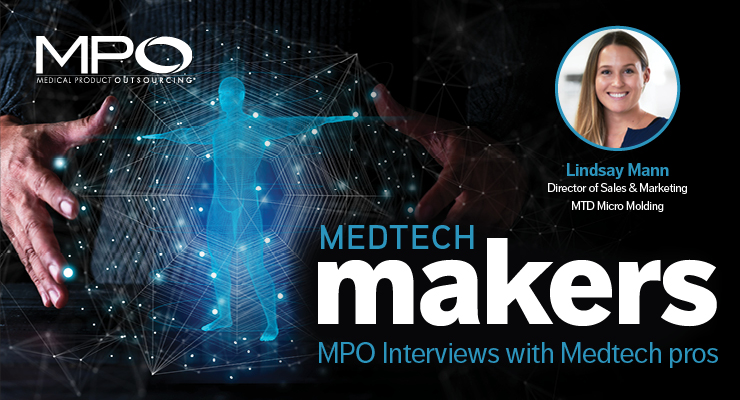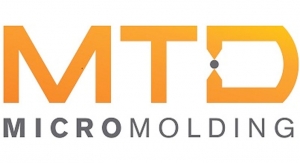By Sean Fenske, Editor-in-Chief
Companies are constantly seeking to iterate quickly through the use of a number of design techniques, including prototyping. When working at a miniature scale, however, prototyping can be a challenge for many suppliers. As a result, it becomes critical to find a partner who can facilitate prototypes at the exact size necessary and in the right materials.
Adding to the complexity can be when bioabsorbable materials are going to be used for the final fabrication. Finding a partner who can not only provide micro-sized prototypes, but also in the bioabsorbable material of choice becomes an even greater challenge.
One company offering a number of solutions for the prototyping of a miniaturized component in a designer’s material of choice is MTD Micro Molding. To provide additional insights on this topic’s specifics, challenges, and considerations, Lindsay Mann, director of sales & marketing at the company, took time to respond to the following questions. She speaks to the importance of prototyping at the miniature level and in a variety of materials.

Machined prototype by MTD Micro Molding, made in a bioabsorbable resin.
Sean Fenske: Prototyping services are fairly common, but how often are they available for micro-sized components?
Lindsay Mann: This is a challenge we hear from our customers—there is a need for fast, cost-effective prototypes for their micro-sized design, and preferably in their material choice. When most OEMs think of prototypes, they think of 3D-printed parts. But often times, OEMs working on micro medical designs need more options to better suit their needs and goals. In response, we have developed multiple prototyping services and pathways to iterate and innovate quickly, and ultimately, get their product to market faster.
Fenske: How does your prototyping offering differ from 3D-printed prototypes?
Mann: Our Forerunner Prototyping Services currently include three options: high-precision 3D printed parts, high-precision machined plastic parts, or micro injection molded parts from a test tool. The 3D-printing service is better for quick turnaround parts to evaluate fit, form, and function of one or multiple designs. The machined option can be leveraged for quickly evaluating a design in one or multiple thermoplastic materials to receive a part design in a designer’s material choice. Finally, the test tooling choice is better for receiving injection molded prototypes, specifically in softer durometer materials or for overmolding.

Fenske: Why is it important to be able to offer prototyped samples in a company’s material of choice?
Mann: Material selection is a critical step in micro-product manufacturability. It drives tolerance, dimension, strength, usability, design, critical features, speed-to-market, and cost. Medical OEMs and start-ups want to ensure they uncover the best material choice for their design before investing in a hardened steel production mold. While 3D printing is fast and cheap, parts are made with a photopolymer, not a thermoplastic representative of their forthcoming injection molded production parts. That is the benefit of our other prototyping services. With our machining and test tooling prototyping services, we can create parts in multiple plastic material options quickly and cost-effectively, and that is invaluable for our customers’ initial testing and evaluation needs.
Fenske: If a product will be implanted and use bioabsorbable materials, how is that type of prototype handled?
Mann: We can provide machined parts in a customer’s bioabsorbable material choice, as long as the material is semi-rigid or rigid.
Fenske: What is the turnaround time for the prototyped samples?
Mann: Depending on the type of prototyping service, the lead time can be as fast as three to five days or require two to four weeks. What’s more important to understand is faster prototypes don’t mean faster speed to market. For example, a 3D-printed prototype of a bioabsorbable component will likely not provide sufficient data for the manufacturability or functionality of the actual bioabsorbable polymer.
Fenske: How does the cost for this type of prototyping service compare with 3D-printed prototypes?
Mann: While 3D-printed prototypes are cheaper, they may not provide the most value for the customer. Our customers have found tremendous value in having a prototype of their design in their actual material, so they can evaluate the physical properties of the part, especially as it may relate to other components on their device. For example, if an OEM is working on an implant design, a machined or test tool prototype can provide a much higher level of information needed upfront in order to make faster, smarter decisions. This can help eliminate material or design assumptions that could delay design freeze.
Fenske: Do you have any additional comments you’d like to share based on any of the topics we discussed or something you’d like to tell medical device manufacturers?
Mann: Our customers have expressed how much they appreciate having a strategic prototyping partner who brings expertise on the micro scale, from material selection to validated production. Having that real-time feedback and expertise on manufacturing feasibility streamlines the entire process.
Learn more about MTD Micro Molding's prototyping services here.
Click here to find out more about MTD Micro Molding >>>>>
Companies are constantly seeking to iterate quickly through the use of a number of design techniques, including prototyping. When working at a miniature scale, however, prototyping can be a challenge for many suppliers. As a result, it becomes critical to find a partner who can facilitate prototypes at the exact size necessary and in the right materials.
Adding to the complexity can be when bioabsorbable materials are going to be used for the final fabrication. Finding a partner who can not only provide micro-sized prototypes, but also in the bioabsorbable material of choice becomes an even greater challenge.
One company offering a number of solutions for the prototyping of a miniaturized component in a designer’s material of choice is MTD Micro Molding. To provide additional insights on this topic’s specifics, challenges, and considerations, Lindsay Mann, director of sales & marketing at the company, took time to respond to the following questions. She speaks to the importance of prototyping at the miniature level and in a variety of materials.

Machined prototype by MTD Micro Molding, made in a bioabsorbable resin.
Sean Fenske: Prototyping services are fairly common, but how often are they available for micro-sized components?
Lindsay Mann: This is a challenge we hear from our customers—there is a need for fast, cost-effective prototypes for their micro-sized design, and preferably in their material choice. When most OEMs think of prototypes, they think of 3D-printed parts. But often times, OEMs working on micro medical designs need more options to better suit their needs and goals. In response, we have developed multiple prototyping services and pathways to iterate and innovate quickly, and ultimately, get their product to market faster.
Fenske: How does your prototyping offering differ from 3D-printed prototypes?
Mann: Our Forerunner Prototyping Services currently include three options: high-precision 3D printed parts, high-precision machined plastic parts, or micro injection molded parts from a test tool. The 3D-printing service is better for quick turnaround parts to evaluate fit, form, and function of one or multiple designs. The machined option can be leveraged for quickly evaluating a design in one or multiple thermoplastic materials to receive a part design in a designer’s material choice. Finally, the test tooling choice is better for receiving injection molded prototypes, specifically in softer durometer materials or for overmolding.

Fenske: Why is it important to be able to offer prototyped samples in a company’s material of choice?
Mann: Material selection is a critical step in micro-product manufacturability. It drives tolerance, dimension, strength, usability, design, critical features, speed-to-market, and cost. Medical OEMs and start-ups want to ensure they uncover the best material choice for their design before investing in a hardened steel production mold. While 3D printing is fast and cheap, parts are made with a photopolymer, not a thermoplastic representative of their forthcoming injection molded production parts. That is the benefit of our other prototyping services. With our machining and test tooling prototyping services, we can create parts in multiple plastic material options quickly and cost-effectively, and that is invaluable for our customers’ initial testing and evaluation needs.
Fenske: If a product will be implanted and use bioabsorbable materials, how is that type of prototype handled?
Mann: We can provide machined parts in a customer’s bioabsorbable material choice, as long as the material is semi-rigid or rigid.
Fenske: What is the turnaround time for the prototyped samples?
Mann: Depending on the type of prototyping service, the lead time can be as fast as three to five days or require two to four weeks. What’s more important to understand is faster prototypes don’t mean faster speed to market. For example, a 3D-printed prototype of a bioabsorbable component will likely not provide sufficient data for the manufacturability or functionality of the actual bioabsorbable polymer.
Fenske: How does the cost for this type of prototyping service compare with 3D-printed prototypes?
Mann: While 3D-printed prototypes are cheaper, they may not provide the most value for the customer. Our customers have found tremendous value in having a prototype of their design in their actual material, so they can evaluate the physical properties of the part, especially as it may relate to other components on their device. For example, if an OEM is working on an implant design, a machined or test tool prototype can provide a much higher level of information needed upfront in order to make faster, smarter decisions. This can help eliminate material or design assumptions that could delay design freeze.
Fenske: Do you have any additional comments you’d like to share based on any of the topics we discussed or something you’d like to tell medical device manufacturers?
Mann: Our customers have expressed how much they appreciate having a strategic prototyping partner who brings expertise on the micro scale, from material selection to validated production. Having that real-time feedback and expertise on manufacturing feasibility streamlines the entire process.
Learn more about MTD Micro Molding's prototyping services here.
Click here to find out more about MTD Micro Molding >>>>>














